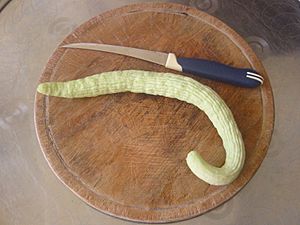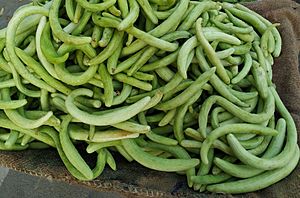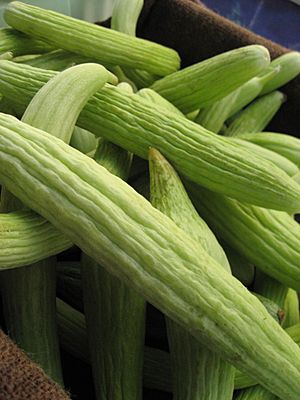Armenian cucumber facts for kids
Quick facts for kids Armenian cucumber |
|
|---|---|
 |
|
| Scientific classification | |
| Kingdom: | |
| (unranked): | |
| (unranked): | |
| (unranked): | |
| Order: | |
| Family: | |
| Genus: |
Cucumis
|
| Species: | |
| Trinomial name | |
| Cucumis melo var. flexuosus (L.) Naudin.
|
|
The Armenian cucumber is a long, slender fruit that tastes a lot like a regular cucumber. Even though it looks and tastes like a cucumber, it's actually a type of muskmelon! This means it's closely related to melons, but also to true cucumbers.
You might hear it called by other names, like yard-long cucumber, snake cucumber, or snake melon. People in different countries have their own names for it, such as chanbar in Persian, tirozî in Kurdish, uri in Japanese, acur in Turkish, and kakadee in Hindi. It's important not to confuse it with snake gourds, which are different plants.
The skin of an Armenian cucumber is very thin, light green, and smooth. It doesn't have any bitter taste, so you can almost always eat it without peeling it first. Sometimes, it's also called a gutah.
Contents
What is an Armenian Cucumber?
The Armenian cucumber is a unique fruit that belongs to the melon family. It's known for its long, thin shape and refreshing taste. Even though it's a type of melon, its flavor and texture are very similar to a common cucumber. This makes it a popular choice for salads and other dishes.
How Does it Grow?
Armenian cucumbers can grow quite long, usually about 30 to 36 inches (76 to 91 cm). They can grow well either on the ground or climbing up a trellis. These plants love sunshine, so they need to be in a sunny spot for most of the day.
The best time to pick an Armenian cucumber for the freshest flavor is when it's about 12 to 15 inches (30 to 38 cm) long. You might find pickled Armenian cucumbers sold in Middle Eastern markets, where they are sometimes called "pickled wild cucumber."
A Look Back in Time
The history of the Armenian cucumber goes back many centuries. In the 18th century, a traveler named Fredric Hasselquist explored places like Asia Minor, Egypt, and Syria. He found a type of cucumber called the "Egyptian or hairy cucumber," which is now part of the Armenian variety.
Ancient Uses
Hasselquist described this cucumber as the "queen of cucumbers." He said it was refreshing, sweet, firm, and healthy. He also noted that it was a big part of the daily food for many people in Egypt. They used it for food, drink, and even as medicine.
Another expert, George E. Post, mentioned that this cucumber was longer and thinner than common cucumbers. It could be over a foot long but less than an inch thick, with pointed ends. This type of cucumber, Cucumis melo subspecies Chate, was very common in ancient Mediterranean pictures and writings. It was likely the kind of cucumber grown all year round for Emperor Tiberius in ancient Rome.
Modern Research
More recently, in 2018, a study looked at melon plants in Israel. The study found that farmers could grow better melons by choosing local types of the plant. Researchers examined plants from 42 different fields. They discovered many differences in how these plants grew, which could help improve local melon farming.
See also
 In Spanish: Melón serpiente para niños
In Spanish: Melón serpiente para niños



